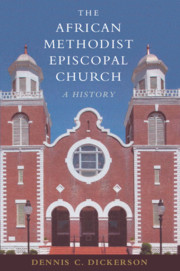Book contents
- The African Methodist Episcopal Church
- The African Methodist Episcopal Church
- Copyright page
- Dedication
- Contents
- Illustrations
- Preface
- Introduction
- 1 Richard Allen and the Rise of African Methodism in the Atlantic World, 1760–1831
- 2 The Freedom Church, 1831–1861
- 3 “Welcome to the Ransomed,” 1861–1880
- 4 A Denomination in the Diaspora, 1880–1916
- 5 Into the Second Century: Migration, Depression, and War, 1916–1945
- 6 Freedom Now! Civil Rights, Black Power, and Anticolonial Insurgencies, 1945–1976
- 7 Becoming a Global Church, 1976–2018
- Epilogue
- Appendix The Bishops of the African Methodist Episcopal Church, 1816–2018
- Bibliography
- Index
4 - A Denomination in the Diaspora, 1880–1916
Published online by Cambridge University Press: 20 December 2019
- The African Methodist Episcopal Church
- The African Methodist Episcopal Church
- Copyright page
- Dedication
- Contents
- Illustrations
- Preface
- Introduction
- 1 Richard Allen and the Rise of African Methodism in the Atlantic World, 1760–1831
- 2 The Freedom Church, 1831–1861
- 3 “Welcome to the Ransomed,” 1861–1880
- 4 A Denomination in the Diaspora, 1880–1916
- 5 Into the Second Century: Migration, Depression, and War, 1916–1945
- 6 Freedom Now! Civil Rights, Black Power, and Anticolonial Insurgencies, 1945–1976
- 7 Becoming a Global Church, 1976–2018
- Epilogue
- Appendix The Bishops of the African Methodist Episcopal Church, 1816–2018
- Bibliography
- Index
Summary
The ongoing growth of the African Methodist Episcopal (AME) Church within multiple constituencies in the black transatlantic required its advocacy and support for issues germane to black freedom. AMEs, for example, became frontline participants in struggles to protect black humanity in the American South, where the civil rights of the ex-slaves were receding, spoke as admirers of Antonio Maceo and other blacks fighting against Spanish colonialism in Cuba, and emerged as defenders of disenfranchised black and colored peoples against white settler hegemony in South Africa. As the denomination matured as an institution with a stable organizational framework and a solid infrastructure of program departments, schools, and transatlantic ministries, its leaders could confidently address black national and international interests and articulate positions, which commanded the attention of powerful whites on both sides of the Atlantic. These developments occurred as the franchise and other civic privileges became more racially restrictive for southern blacks and as various pan-African projects increasingly tied diverse black populations to the AME Church. Despite the breadth of the denomination’s Atlantic consciousness, self-referential attitudes confined their success mainly to creolized peoples in the Caribbean and Africa and even among ex-slaves in the American South.
- Type
- Chapter
- Information
- The African Methodist Episcopal ChurchA History, pp. 157 - 236Publisher: Cambridge University PressPrint publication year: 2020

